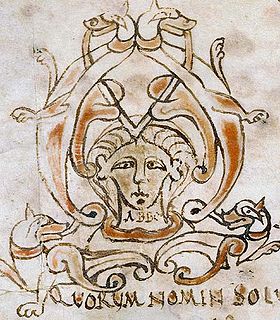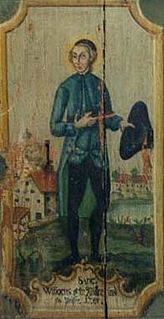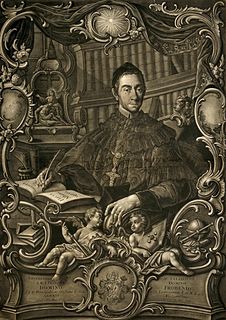Biography
Lambert was born about 1060 of a distinguished family, and, when still young, entered the French Benedictine abbey of St-Bertin. He afterwards visited several famous schools in France, having first laid the foundation of his subsequent learning by the study in his own monastery of grammar, theology and music. For some time he filled the office of prior, and in 1095 was chosen abbot at once by the monks of St-Bertin and by the canons of St-Omer. He was thus drawn into closer relations with Cluny, and instituted through the Cluniac monks many reforms in his somewhat deteriorated monastery. Needless to say, he encountered no little opposition to his efforts, but, thanks to his extraordinary energy, he finally secured acceptance for his views, and rehabilitated the financial position of the monastery. He was a friend of St. Anselm and exchanged verses, still extant, with the poet Reginald of Canterbury (ed. Libermann in "Neues Archiv der Gesellschaft fur altere Geschichte", XIII, 1888, pp. 528; 531-34). He died on 22 June 1125, at St-Bertin.

Prior, derived from the Latin for "earlier, first", is an ecclesiastical title for a superior, usually lower in rank than an abbot or abbess. Its earlier generic usage referred to any monastic superior.

Abbot, meaning father, is an ecclesiastical title given to the male head of a monastery in various traditions, including Christianity. The office may also be given as an honorary title to a clergyman who is not the head of a monastery. The female equivalent is abbess.

A canon is a member of certain bodies subject to an ecclesiastical rule.
Works
Even during his lifetime, Lambert was lauded in glowing terms for his great learning by an admirer —not a monk of St-Bertin— in the "Tractatus de moribus Lamberti Abbatis S. Beretini" (ed. Holder-Egger in "Monumenta German. Histor. SS.", XV, 2, 946-53). This work mentions several otherwise unknown writings of Lambert, e.g. "Sermones de Vetere Testamento", also studies on free will, the Divine prescience, original sin, origin of the soul and questions of physical science.

The Monumenta Germaniae Historica is a comprehensive series of carefully edited and published primary sources, both chronicle and archival, for the study of Northwestern and Central European history from the end of the Roman Empire to 1500. Despite the name, the series covers important sources for the history of many countries besides Germany, since the Society for the Publication of Sources on Germanic Affairs of the Middle Ages has included documents from many other areas subjected to the influence of Germanic tribes or rulers. The editor from 1826 until 1874 was Georg Heinrich Pertz (1795–1876); in 1875 he was succeeded by Georg Waitz (1813-1886).

Free will is the ability to choose between different possible courses of action unimpeded.

Original sin, also called ancestral sin, is a Christian belief in the state of sin in which humanity has existed since the fall of man, stemming from Adam and Eve's rebellion in Eden, namely the sin of disobedience in consuming the forbidden fruit from the tree of the knowledge of good and evil. This condition has been characterized in many ways, ranging from something as insignificant as a slight deficiency, or a tendency toward sin yet without collective guilt, referred to as a "sin nature", to something as drastic as total depravity or automatic guilt of all humans through collective guilt.
Although the two are often confused, he is not identical with Lambert, the Canon of St. Omer who wrote the famous "Liber Floridus", a kind of encyclopedia of Biblical, chronological, astronomical, geographical, theological, philosophical and natural history subjects, which was completed in 1120.

Liber Floridus is a medieval encyclopedia that was compiled between 1090 and 1120 by Lambert, Canon of Saint-Omer. The text compiles extracts from some 192 or so different works.
This page is based on this
Wikipedia article Text is available under the
CC BY-SA 4.0 license; additional terms may apply.
Images, videos and audio are available under their respective licenses.

Primate is a title or rank bestowed on some archbishops in certain Christian churches. Depending on the particular tradition, it can denote either jurisdictional authority or (usually) ceremonial precedence.

Abbo or Abbon of Fleury, also known as Saint Abbo or Abbon, was a monk and abbot of Fleury Abbey in present-day Saint-Benoît-sur-Loire near Orléans, France.

Ernulf was a French Benedictine monk who became prior of Christ Church in Canterbury, abbot of Peterborough, and bishop of Rochester in England. A jurist and an architect as well, he was responsible for greatly expanding Canterbury Cathedral during his time there.

Bertin, also known as Saint Bertin the Great, was the Frankish abbot of a monastery in Saint-Omer later named the Abbey of Saint Bertin after him. He is honored as a saint by Catholic Church.

Liessies Abbey was a Benedictine monastery in the village of Liessies, near Avesnes-sur-Helpe, in the Archdiocese of Cambrai and the département of Nord, France.

Gembloux Abbey was a Benedictine abbey near the town of Gembloux in the province of Namur, Belgium.
Haymo was a German Benedictine monk who served as bishop of Halberstadt, and was a noted author.
Saint Audomar, better known as Saint Omer, was a bishop of Thérouanne, after whom nearby Saint-Omer in northern France was named.
Geoffrey of Vendôme was a French Benedictine monk, writer and cardinal.

Saint Winnoc was an abbot or prior of Wormhout who came from Wales. Three lives of this saint are extant. The best of these, the first life, was written by a monk of St. Bertin in the middle of the ninth century, or perhaps a century earlier.
Marianus Scotus of Regensburg, born Muiredach mac Robartaig, was an Irish abbot and scribe.
Benedictus van Haeften was the Provost of Affligem Abbey and a writer of religious works.
Frowin of Engleberg, in German Frowin von Engelberg was a Swiss German Benedictine abbot. Though never formally beatified, Frowin was styled "Blessed" by some chroniclers.
Celestino Sfondrati was an Italian Benedictine theologian, Prince-abbot of St. Gall and Cardinal.

Frobenius Forster was a German Benedictine, Prince-Abbot of St. Emmeram.
The Monastery of Our Lady of Jordan was a Strict Observance Cistercian (Trappist) monastery in the community of Jordan in Linn County, Oregon, United States, founded in 1904 and lasting for about six years.
Augustine Reding was a Swiss Benedictine, the Prince-Abbot of Einsiedeln, and theological writer.
François Delfau was a French Benedictine theologian, an authority on patristic theology.
Ludwig Engel was an Austrian Benedictine canon lawyer.














